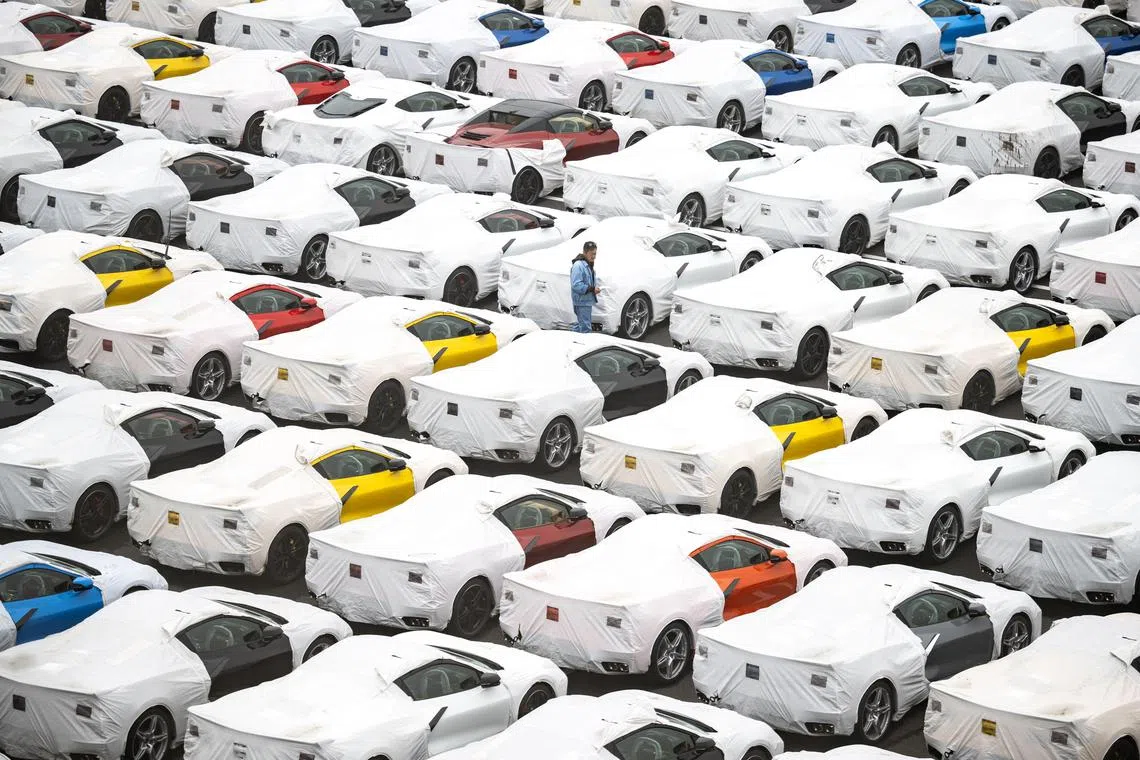Confusion over tariff stacking hampers Japan’s bid to pin down US trade deal
Sign up now: Get ST's newsletters delivered to your inbox

Japan is urging US President Donald Trump to lower tariffs on cars to 15 per cent from 27.5 per cent.
PHOTO: AFP
Follow topic:
TOKYO – A fresh discrepancy in interpretations of the US-Japan trade deal came to the fore on Aug 7, as Japan’s chief negotiator visits Washington to press for follow-through on a pledge to cut a duty on car imports to 15 per cent.
Japanese media reports said Washington would not exempt Tokyo from an order stacking new 15 per cent across-the board tariffs on top of existing duties, hours before they take effect.
Top Japanese trade negotiator Ryosei Akazawa had earlier disputed such an understanding.
“There will be no stacking,” Mr Akazawa said on Aug 5 before leaving for Washington. “There’s mutual understanding on this matter.”
The 15 per cent rate will replace existing rates on items that currently face duties of less than 15 per cent, while items already saddled with duties higher than 15 per cent will see no change, according to Japan’s Cabinet Secretariat.
Asked about the matter on Aug 7, Japan’s chief spokesman Yoshimasa Hayashi said Mr Akazawa has reconfirmed the agreement on universal tariffs with the US.
Mr Akazawa met US Commerce Secretary Howard Lutnick on Aug 6 in the US, reiterating the terms of the trade agreement reached in July
The top priority for Japan is to have the US follow through as soon as possible on a promise to cut car tariffs.
July’s deal also included a pledge to change the universal duty on Japan to 15 per cent, up from the 10 per cent baseline but lower than a threatened 25 per cent.
The new rate is to take effect on Aug 7, but the discord over stacking shows the two sides are not on the same page over details and implementation steps.
Kyodo News cited an unidentified White House official as saying the 15 per cent duty would be added to current tariffs.
That is in line with an executive order released by the US administration last week, which indicated the 15 per cent cut-off applied to the European Union but did not state that it would apply to Japan.
The discrepancy may be limited in scope.
Before President Donald Trump began announcing new tariffs on nations around the world, the US had applied duties averaging 1.4 per cent on Japanese goods, according to estimates in February by Professor Kenichi Kawasaki at the National Graduate Institute for Policy Studies in Tokyo.
More importantly, Japan is urging Mr Trump to lower tariffs on cars to 15 per cent from 27.5 per cent, a combination of an existing 2.5 per cent and an additional 25 per cent, as agreed upon in the deal.
It remains unclear when the change will take place.
Implementing the deal is one of the reasons Japanese Prime Minister Shigeru Ishiba has cited for staying in his role even after his ruling party suffered a historic election loss
“There are all sorts of debates over the tariffs, but we have reached an agreement,” Mr Ishiba said at a press conference in Hiroshima on Aug 6.
“As stated by US government officials involved in previous US-Japan trade negotiations, it is much, much more difficult to implement the deal than to agree on it.” BLOOMBERG

